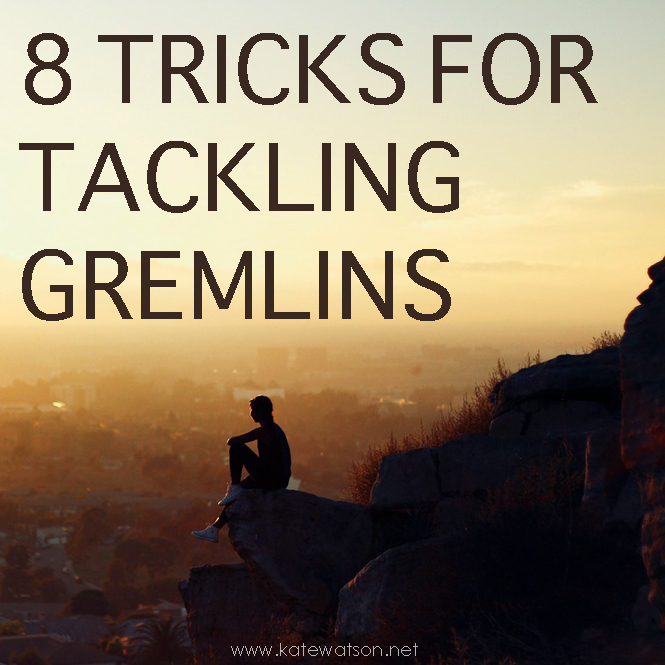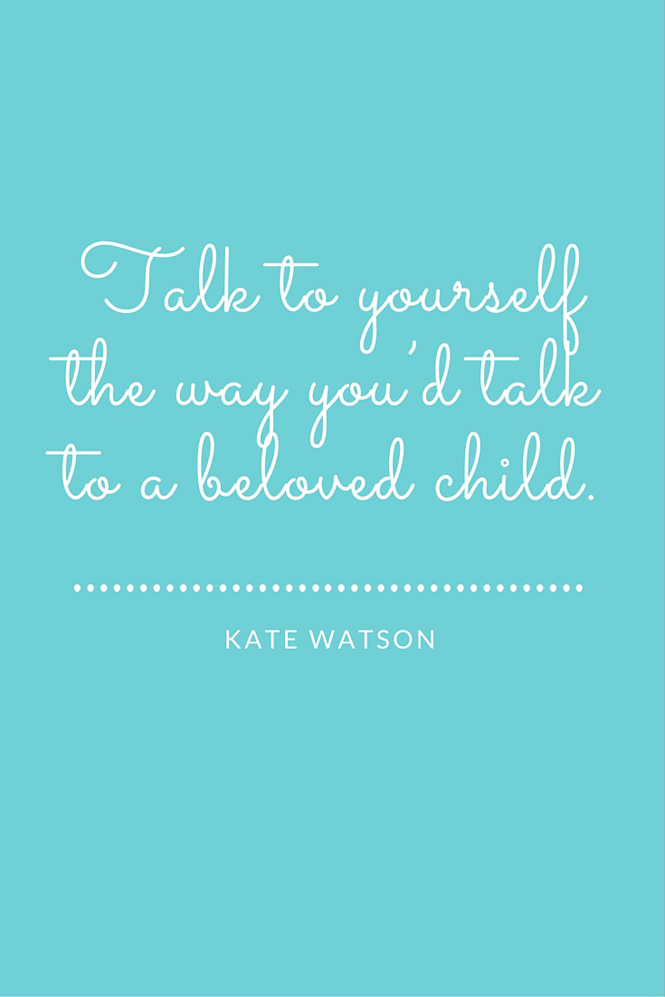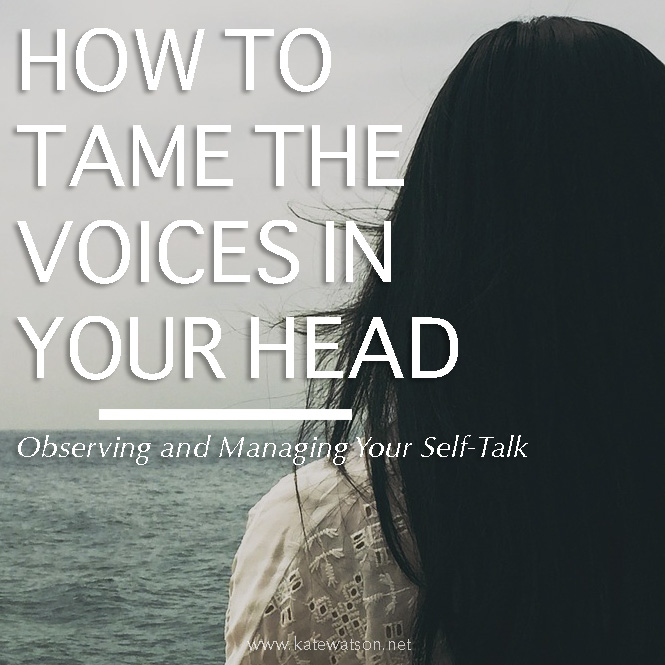
The other day, Mr. Watson expressed some doubts about his career. I knee-jerkingly replied, “Are you kidding? You’re a rockstar.” And he is, by my definition: He holds four patents, is one of a small number of non-PhDs ever to work at HP Labs, and is now a principal software engineer at a funded startup.
“I’m allowed to have moments of doubt,” he said.
“Of course you are,” I responded. “You’re allowed to feel any way you want, but is that how you really want to feel?” It’s so much easier to see someone else’s stuff, isn’t it?
The point is, we all have voices in our heads that tell us we aren’t good enough. I call these voices gremlins and they can do a real mind trip, can’t they? They know exactly what to say to undermine our progress.
Gremlin is just one name for these voices. When I Grow Up Coach Michelle Ward calls them vampires. Author and founder of the Playing Big leadership program Tara Mohr calls them inner critics. Whatever you call them, they’re all manifestations of self-doubt that lead to self-sabotage by convincing us that we’re not worthy to have what we want.
Researcher and author Brené Brown says our gremlins’ messages take two forms, either “you’re not good enough” or “who do you think you are?” Both keep us playing small, the first by reminding us that we’re not going to make it anyway and the second by belittling the wisdom and value we do have.
In her book Playing Big, Tara Mohr devotes an entire chapter to the inner critic. Through it, she shares the differences between the irrational voice of your inner critic and the realistic thoughts you might have instead. Among them:
- Your inner critic is mean, biting, and repetitive. It might, for example, say “You’re just not smart enough… You’re not smart enough… You really aren’t smart enough” despite any objections you voice. When you’re thinking more rationally, you’re better able to consider alternatives and seek solutions such as, “Maybe I don’t know enough yet, but I can learn.”
- Your inner critic makes definite pronouncements while a rational response would entail asking yourself such questions as, “How could I accomplish this?”
- Your inner critic employs black-and-white thinking whereas your realistic self is comfortable with complexity and gray areas.
- Your inner critic may be based on something said to you in the past, perhaps by a parent or teacher or conveyed through societal expectations, whereas your rational voice is generally a calmer, wiser version of you.
Your inner critic or gremlins aren’t really trying to hurt you; they’re there to protect you. Of course, because they keep you from pushing yourself or exposing your vulnerabilities, listening to them may keep you from ever reaching your goals.
8 Tricks for Tackling Your Gremlins
When your gremlins are biting, here are some ways to respond:
- Breathe. First, take a deep breath, focusing on your full inhalation and exhalation. Doing so helps to bring you back to the present and re-centers yourself.
- Acknowledge. Observe that your gremlins are biting. Rick Carson writes in the book, Taming Your Gremlin, “Don’t grapple with your gremlin. Simply notice him or her fully, and then choose to redirect your awareness—or not.”
- Redirect. As Rick Carson suggests, you might need to move on to something else—to redirect your focus—but beware that this can get in the way of accomplishing something important, if you let it.
- Thank them. Tara Mohr writes, “One of my favorite things to say back to my own inner critic…is: ‘Thanks, but I’ve got this one covered.’” She emphasizes her “thank you” is offered in sincere appreciation for her gremlin’s attempt to keep her from embarrassment or failure.
- Change the narrative. As I wrote in last week’s post, sometimes you need to give yourself a pep talk. Consciously engage in positive self-talk, not responding to the gremlins per se but change the narrative and open yourself to seeing new possibilities. For example, if your gremlin says, “You’re a fat slob,” instead say, “Ok, I want to lose some weight; how can I do that?”
- Revisit the love. Read notes of encouragement or gratitude you’ve received in the past. If you keep a win book, as Michelle Ward recommends, you’ll have all of these lovely notes as well as reminders of your prior accomplishments in one place, which makes it easy.
- Analyze it. Brené Brown recommends that you write down the message and then later ask yourself if it’s true. As I shared last week, writing down your thoughts gets them out of your head and onto paper, where you can review them rationally and thoughtfully.
- Rebut. Michelle Ward suggests that you can go one step further by writing down rebuttals, as if you were an attorney arguing in a court of law. While no one suggests that you attempt to rebut the gremlins in the midst of an attack, it can help change your long-term perspective and narrative when you take note of the messages you’re telling yourself and determine whether they’re fair, true, and helpful.
Remember, your gremlins aren’t here to harm you—even if some of their messages arose from unpleasant experiences. Your gremlins are simply voices that keep you in your comfort zone. Once you realize they come from a place of self-protection, you’ll have the power to accept or move past them.
Brené Brown has a sign in her office that reads, “Talk to yourself the way you’d talk to someone you love.” I’d go a step further and say, “Talk to yourself the way you’d talk to a beloved child.”
Don’t we all have a part of ourselves that’s still a scared, overwhelmed child? Be kind to her.

For additional resources on gremlins/inner critics/vampires, check out:
Cheers,

This post is part of the Weeks of Self blog series, hosted by Theresa Destrebecq of Thrive Within.

We all have voices in our heads. No, I’m not talking about multiple personality disorder. I’m talking about self-talk.
What is Self-talk?
Self-talk provides the narration for our human experience, it’s the stream-of-conscious thoughts that flit through our minds and help us understand our reality. Notice that I didn’t say it narrates reality. As Michael A. Singer writes in The Untethered Soul, “Your consciousness is actually experiencing your mental model of reality, not reality itself.”
Sometimes the voices in our heads relay facts or observations such as: “Oh, I was supposed to call Bob today. I could call him now, but I don’t have my hands-free set. I suppose I’ll have to call him when I get home. I don’t really want to talk to him now…but I need to do this. It’s the responsible thing to do.”
Sometimes the voices praise us, “Yeah, I rocked that presentation! That was awesome.”
And sometimes the voices turn downright nasty, “Well that was colossally stupid. I just made a huge fool of myself…”
Recently my self-talk has been dominated by Elle King’s “Ex’s & Oh’s” lyrics and flashes of business insight at 3am, when I’d prefer to be asleep. I know you know what I’m talking about.
Because self-talk illustrates our mental model of reality, it can be a powerful self-discovery tool. Our self-talk points to our immediate, subconscious responses to experiences; reflects deeply held beliefs about ourselves and the world; and has a significant impact on how we feel and behave.
How to Become More Aware of Your Self-Talk
To learn more about yourself through your self-talk, first you must notice what the voices are saying. We each have thousands of thoughts per day, so many that we may be unaware of most of them. Paying attention to our self-talk is thus an exercise in mindfulness. I’ve found three methods that help in observing my mental chatter:
Meditation. Designed to help you achieve mental peace, meditation is an excellent way to observe your self-talk—because your mind will fight to distract you.
When you first start meditating, you might try to silence your thoughts by focusing on your breath, but those sneaky voices often pop in anyway. As they do, you can acknowledge them and move back to your breathing then, once meditation has finished, make a note of what thoughts sprang to mind.
Regular meditation also provides a key to managing your self-talk by helping you learn to not react to every thought in your head and instead to watch detachedly, as if from a distance.
Exercise. Have you ever gotten into the flow of exercise and become more conscious to your thoughts? My husband swears by running for this purpose. There’s something about the rhythmic, repetitive motion that distracts enough of his brain so that he can be more aware of his underlying thoughts.
I’ve found this to be true for myself through yoga and walking. Focusing on the movement of my body calms my mind to the point where I become more attuned and better able to observe my thoughts. The secret to reaching this state is to exercise alone and without distractions. Sorry, iPod.
Journaling. My favorite way to observe my self-talk is through journaling. Since 2010, I’ve written morning pages, three pages of handwritten, stream-of-conscious notes each day. I also kept a journal for many years before that.
Writing down your thoughts, especially first thing in the morning or when your mind is going a million miles per minute, helps you see your mental models, the stories you tell yourself to make sense of the world. Having these thoughts written down also gives you a leg up on the second part of this work, managing your self-talk.
How to Manage Your Self-Talk
Once you’ve developed a habit of observing your self-talk, you can determine if it is positive or negative, empowering or disempowering. When I first started, mine was profoundly negative. It was only because I became aware of that, though, I was able to change it.
Question it. When you’re observing your thoughts, you can ask yourself: Is this fair, true, and helpful? Do I want to believe this message?
If it helps you, great! You can work to strengthen positive self-talk by acknowledging it. If your thoughts aren’t so helpful, knowing this will provide the impetus to make needed changes.
Pep it up. You can change inherent self-talk by giving yourself a pep talk. Admittedly, this doesn’t work too well when you’re in a negative spiral and is best attempted when you’re nervous and need to psych yourself up for a strong performance.
When I photographed my first few weddings, for example, I had the following conversation with myself as I drove to the event: “You’ve got this, Kate! You’re a good photographer. You’re going to stay in the moment, focus on what’s happening around you, see the shot, and capture it.” Sometimes I’d even say this out loud for emphasis.
According to psychologist Bridgett Ross, what I did was a combination of motivational and instructional self-talk, not only encouraging myself but providing specific action steps to accomplish my goal. The combination of the two is stronger than motivational words alone.
Rewrite your story. One more way to improve your mental state and related self-talk is by working with positive affirmations. I’ve written about affirmations before so I won’t go into too many details here. To create affirmations that work, remember to phrase them in the positive, focus on the present tense, and keep them believable. If no part of you believes what you’re peddling, your mind will ignore it or worse, scoff at it.
Next week I’m going to delve a bit deeper into self-talk and tackling your gremlins, those nasty voices that kill your spirit and undermine your progress. Until then, enjoy the next Weeks of Self post, going live on Wednesday from Sara Yao.
Cheers,


In December 2009, I was deep in the throes of creative burnout. I had just wrapped up a wedding season and returned from an overseas volunteer trip providing product photography.
“My favorite definition of burnout is this: burnout is not about giving too much of yourself, it’s about trying to give what you do not possess.” – Shelley Prevost
Most people believe that burnout stems from giving too much and, while that is one factor, the bigger picture is, as Shelley Prevost says, “trying to give what you do not possess.”
Sure, I’d worked hard during wedding season but I was wrecked from putting other people’s needs above your own, from trying to be what others wanted me to be. For too long, I’d tried to market my business the “right way” or shoot according to each client’s expectations, even when those didn’t match my individual strengths.
When you try to give what you don’t have to keep others happy, you can’t help but reach burnout.
What I Did to Recover from Creative Burnout
As I began thinking about how to recover, I knew two steps would be critical: taking time off and rediscovering what inspired me. Luckily, my husband and I had already decided to take some time to travel, and so that is where I began.
What followed wasn’t a step-by-step path so much as an exploration of different ways to rediscover my inner muse. Here’s what I did:
Took time off. As I said, I was lucky to have already made time to rest and recharge. Whether you need one day of intensive couch time and rerun watching or a longer vacation to relax and refresh, recovering from creative burnout requires some separation from your daily activities or, at the very least, a change of focus from tasks that are adding to your stress to those that will help alleviate it.
Studied The Artist’s Way. I owned a copy of Julia Cameron’s book, The Artist’s Way, for years before reading it. While traveling, I proposed to a friend that we give it a try—after all, it’s a course about discovering and recovering your creative self. It turned out to be transformative, for both of us.
Uncovered my truth. In The Artist’s Way, Julia proposes two basic tools to discover or recover your creative self, the first of which is morning pages. Morning pages are three stream-of-consciousness pages that you handwrite each day. It’s good practice to write whatever comes to your mind, whether or not you have anything important to say, even if it’s “this is stupid and I have nothing to say.”
The real power of morning pages is that they force you to pay attention to your inner monologue, to see what’s truly going on in that beautiful head of yours. Eventually, they also become a source of tremendous clarity and insight, a place where you encounter regular ahas!
As Jenna Avery writes, “Fundamentally, morning pages give you permission to be who you are. They are a radical form of self-acceptance.” Exactly! Through morning pages, I uncovered my voice and truth.
Spent time with my muse. The second essential tool in The Artist’s Way is an artist date, a block of time set aside each week to nurture your inner muse. Initially I struggled with making time for an artist date but that’s the point. Just as your spouse and children need quality time, so does your inner artist. An artist date ensures that quality time is allocated.
During artist dates, I visited bookstores or craft stores, bought coloring books and pencils, saw movies, and went to the beach or for walks. As a diehard introvert, sometimes I spent my date at home, brewing tea and making an event out of vision-boarding or designing a piece of jewelry.
I believe it was through this forced attention to my creative self that I found the inspiration to explore new creative outlets in the months that followed.
Explored inspirations. I’ve always been intrigued by what drives other people and so, when I began to feel a tug to do so, I reached out to several artists and studied their creative outlets: glassblowing, lampwork beadmaking, origami, silversmithing, art clay silver, jade carving, oil and watercolor painting, and more.
Exploring so many new art forms inspired me in several ways: It validated the concept of living a creative life by introducing me to interesting people who were already doing so, it brought my own creativity roaring back to life (because it was safe to dabble and be a beginner in a new medium), and it helped me accept the “artist” moniker myself.
Ironic, isn’t it, that a professional photographer didn’t view herself as an artist? Now, thanks to this period of creative exploration, I believe we are all artists, just with different mediums—from novel writing to landscaping and everything in between.
Retained a beginner mindset. After reigniting my creative spark, when I could imagine picking up my camera again, I had to remind myself to retain the beginner mindset I’d discovered while exploring new pursuits.
Beginners are allowed to try new methods and make mistakes, things professionals rarely allow themselves. Although it’s easier to play and practice in a new medium, taking your work too seriously can send you right back into burnout. Let go of seriousness and embrace the joy.
Eased back into the work. When I began to feel reinvigorated for creative work, I took it slowly, easing back into it. I paid attention to how I felt about different elements of it. When something didn’t feel right, I paused and asked myself what could improve the situation.
Of course, sometimes I went too far, and got a bit burned. I’d get excited and overcommit. Afterward, I did what we all have to do and learned from the mistakes and kept moving forward, slowly and cautiously.
Honored my needs. Because creative burnout stems from not honoring your needs—from trying to be all things to all people—my biggest takeaway from the recovery process was learning to honor my needs.
This is not an easy process. A people-pleaser through and through, I often become stressed and feel obligated to do things I don’t want to do. Now I know that will just lead me back into burnout, however, and so I remind myself that it’s okay to rest when I need to and to say ‘no’ if I don’t want to do something. That is the only way to ensure that creative burnout remains a thing of my past.
As I’ve said before, recovering from creative burnout isn’t a linear process. You may have to return to some lessons again and again, and you may skip others completely. I hope that reading about the tools I used and discoveries I made during my creative recovery helps you to uncover your creative spirit in your own way.
If you feel like I missed something or would like to share an element of your own creative burnout or recovery, let me know in the comments.
Cheers,

P.S. Because Julia Cameron’s The Artist’s Way proved to be an essential part of my creative recovery, I’m bringing her teachings to you in a special program next year. The Artist’s Way Creative Cohort is an opportunity to discover or recover your creative spirit within a supportive, small group of like-minded women. Get on this list to be notified when registration opens and receive a special bonus.

On this cool November evening, I’m envisioning you curled up on your sofa with a fuzzy blanket, sipping tea from your favorite floral mug, and watching guilty pleasure television while you casually scroll through your Facebook feed and skim news stories on your iPhone.
Why? Because what I know about you, thanks to your responses to last month’s reader survey, is that you and I are kindreds. And that’s what I’m doing, too; well, minus the phone and plus my MacBook Pro. Consummate multi-taskers, aren’t we?
I’ve decided to share the findings of my reader survey so that you know you were heard and I can convey my vision for this site and my work, based on your feedback. Here’s what I know about you:
#1. You’re a woman.
Despite my Google Analytics account suggesting that 55% of this blog’s readership is male, I know you’re a woman. Not only were 100% of the responses to my reader survey from women (yep, every. last. one.), all of my current course participants are women, and more than 90% of my newsletter subscribers are women. So, you’re a woman—or a particularly uncommunicative male.
#2. You’re close to my age.
There was some variation here, for sure; however, you’re probably somewhere between 30 and 45. That makes sense because our 30s seem to be the time we start bringing who we really are and what we want most into being. Let’s do this, sister!
#3. You love personal development.
While a few survey responders were interested in world-changing ideas and inspiring people, the vast majority of you want to read about personal growth, self care, and relationships. Great! I want to write about those things, too, so we’re on the same page.
I’ll also throw in some posts about inspirational people and ideas here and there, but I know that large-scale change begins with personal change and so that’s the best place to begin.
#4. You want more stories.
Personal stories and my art and photography led the way on what you’d like to see on this blog. Guest posts and interviews were also popular and there was a significant minority who wanted some audio and video and other people’s art and photography.
Here’s what that means for you: There will definitely be more personal stories going forward. I’m also reaching out to interesting women to guest post and share their views—particularly in areas outside my expertise—on topics that interest busy women like us.
#5. You want personal attention.
Who doesn’t, right? You’re intrigued by the idea of in-person retreats and small group programs, and you might be interested in a downloadable guide, short email course, or webinar, if it was on the right topic and at the right time.
I’ll have to work some magic on developing that retreat; I have some ideas but I’ll need a co-conspirator or two to bring it into being. However, a small group program is on the horizon. Stay tuned for details next week.
So, there you have it. This is what I know about you after reading your responses to the reader survey.
If I missed something—like that you’re really a man! (j/k)—please let me know in the comments or hop on over and take the survey.
Cheers,


When you think ethical fashion, you might also think mucho dinero. Since fast fashion has taught us that t-shirts should be $10 or less, slow fashion must cost a lot more, right? Not really.
You needn’t spend your whole paycheck to feel good about the clothes you’re buying. Increasingly, there are a number of affordable brands dedicated to the production of ethical fashion.
Last week, fashion designer Alice Grau shared 12 simple strategies to combat this era of fast fashion by reducing, reusing, and recycling your clothing. This week, I asked her to share some of her favorite brands and resources to help you choose sustainable options when you make clothing purchases.
8 Ethical Fashion Brands You Can Afford + Feel Good About Buying
It’s only fair to begin Alice’s list with her employer, Global Mamas, a fair trade producer based in Ghana. Since 2003, Global Mamas has worked with local artisans to produce men’s, women’s, and children’s clothing and housewares made from hand-batiked textiles, recycled glass-bead jewelry, and accessories from recycled plastic. In the interest of full disclosure, I also volunteered with them in 2009.

Maggie’s Organics began with a question: Was it possible to establish a successful, sustainable business while protecting the limited resources of the planet, and respecting and dignifying each worker who makes the business run? Working directly with cotton growers in the Americas and producing over 65% of their products in the U.S.A., Maggie’s is able to minimize its carbon footprint for the organic cotton apparel they create, from socks, tights, and leggings to tops, tees, and skirts. Each product’s farm-to-finish story is shared on their website.

Since 2004, Marigold has been working with a co-op of over 600 women from the slums of Mumbai to create fashionable fair trade clothing. With a product line similar to Global Mamas’, they produce clothing and housewares from hand block printed and organic fabrics.

A design driven, fair trade brand, Mata Traders’ colorful, original designs are made by artisans in India and Nepal and sold across the United States and 12 additional countries. They produce women’s clothing (including a curvy line), jewelry, accessories, and home decor. Personally, I love their earrings.

Designed in New Orleans and made in India, Passion Lilie is a fair trade and eco-friendly apparel brand with a mission to empower artisans across the world by creating dignified employment opportunities. The Passion Lilie collection is vintage and retro inspired, made with 100% Indian cotton and hand block printed or hand woven with eco dyes. They produce women’s apparel, outerwear, and accessories.

UK-based People Tree makes beautiful garments that are a living blueprint for their values that people and the planet are central to everything they do. Their clothing is hand crafted in organic cotton and sustainable materials, using traditional skills that support rural communities. People Tree is one of the only brands on this list to offer a real men’s line and, coming in at around $50 for a knit shirt, it is also a splurge brand.

prAna is a pioneering Fair Trade USA brand partner. In addition to its Fair Trade practices, the company uses sustainable materials that have a reduced environmental impact such as recycled polyester and organic cotton. They carry a full line of men & women’s apparel, swimwear, and accessories.

Raven + Lily is an ethical fashion and lifestyle brand dedicated to empowering women through design. A certified B Corporation, the company was named the Best for the World in Community Impact. Raven + Lily offers jewelry, women’s apparel and accessories, and luxury home goods. With its beautiful clothing, this is definitely another splurge brand!

As I stated at the outset, these are just a few of the ethical fashion brands out there. Here are some resources to discover more:
If you want to learn more about why the clothing you buy matters, check out Lifehack’s 8 Reasons to Rethink Fast Fashion and last week’s post.
In what areas do you want to learn more about being a conscious consumer? Skincare? Cleaning products? Groceries? Please let me know in the comments.
Cheers,

|






















8 Tricks for Tackling Your Gremlins » KateWatson.net - […] the narrative. As I wrote in last week’s post, sometimes you need to give yourself a pep talk. Consciously engage in positive self-talk, not […]
Kate Watson - Hi Paula – So happy to hear you liked it! Thanks for your comment.
Paula - Hi Kate – I love this thoughtful and mindful approach to engaging with self-talk 🙂
Paula